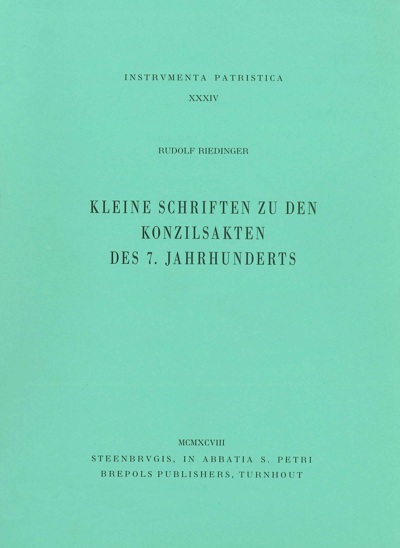
Cassiodorus Senator
Le Institutiones humanarum litterarum di Cassiodoro
Commento alle redazioni interpolate Φ Δ
Ilaria Morresi
- Pages: 554 p.
- Size:156 x 234 mm
- Illustrations:72 b/w, 15 tables b/w.
- Language(s):Italian, Latin
- Publication Year:2023
- € 125,00 EXCL. VAT RETAIL PRICE
- ISBN: 978-2-503-59590-0
- Hardback
- Available
- € 125,00 EXCL. VAT RETAIL PRICE
- ISBN: 978-2-503-59591-7
- E-book
- Available
Genesis and afterlife of Cassiodorus’ influential synthesis of secular learning
« (...) le volume de commentaire fournit un très intéressant exemple de la manière dont on peut traiter des rédactions interpolées ou augmentées. (...) Œuvre massive, qui témoigne déjà d’une étude approfondie de la réception et de la transformation des Institutiones humanarum litterarum de Cassiodore, cette double publication [CC SL 99A & IPM 88] intéressera non seulement les spécialistes de cet auteur, ceux qui s’intéressent aux disciplines grammaticales et mathématiques et à l’enseignement dans l’Antiquité tardive et au Moyen Âge, mais devrait aussi retenir l’attention de tous les éditeurs de textes, en particulier lorsqu’ils sont confrontés à des traditions complexes et vivantes, qui ne se figent pas immédiatement dans un texte d’auteur. » (Matthieu Cassin, « Bulletin de patrologie », Revue des Sciences philosophiques et théologiques, 107-3, 2023, p. 573)
Ilaria Morresi studied Latin Philology and Paleography at the Scuola Normale Superiore of Pisa, where she obtained a PhD in Sciences of Antiquity in 2019. She also graduated in Paleography and Archive Management at the Scuola Vaticana di Paleografia, Diplomatica e Archivistica in 2018, and is currently junior lecturer at La Sapienza University in Rome. Her main research interests include paleography, codicology, the circulation of texts in the early Middle Ages, and the medieval reception of ancient literature.
The Institutiones humanarum litterarum – that is, the second book of Cassiodorus’ masterpiece, devoted to secular learning – have come down to us in three different textual forms: the ‘authentic’ recension Ω, corresponding to Cassiodorus’ final wishes, and two subsequent recensions, designated as Φ and Δ. In these two recensions, later interpolations were added on the basis of an earlier authorial draft, providing modern readers with valuable information both about Cassiodorus’ progressive revisions and about the early fortune of his work.
This volume provides a full commentary to the first critical edition of the interpolated recensions Φ and Δ (CC SL 99A). In doing so, it conveys a full picture of the complex history of the Institutiones saeculares, from their first appearance in the monastery of Vivarium to the Carolingian Renaissance, at which time they knew their greatest success and circulation.
Parte I: Le redazioni d’autore delle Institutiones humanarum litterarum
I. Introduzione e stato dell’arte
1. Caratteristiche e contenuto delle tre redazioni
2. Rimaneggiamenti delle Institutiones
3. Redazioni intermedie delle Institutiones humanae
4. Alcune obiezioni all’ipotesi tradizionale di Courcelle
5. Piano del presente lavoro
II. Il testo-base di Φ Δ: varianti d’autore alle Institutiones
1. Un ulteriore rimaneggiamento d’autore φ alla base di II?
2. Analisi testuale di ω: errori d’archetipo nel brouillon
3. Il brouillon di Cassiodoro è stato scritto a Vivarium?
Parte II: La redazione II
I. Interpolazioni interne alle Institutiones
1. Gli estratti da Marziano Capella
2. Gli estratti dal De topicis differentiis di Boezio
II. L’appendice II
1. Il trattato De topicis
2. De syllogismis, De paralogismis e De propositionum modis
3. Il Computus Paschalis
4. I Praecepta artis rhetoricae di Severiano
5. Il trattato De dialecticis locis
6. Conclusioni sull’Appendice II
Parte III: La redazione III
I. Institutiones humanarum litterarum
1. Il capitolo De grammatica
2. Il capitolo De rethorica
3. Il capitolo De dialectica
4. I capitoli del Quadriuium
5. Conclusioni sulle Institutiones Δ
II. Interpolazioni lunghe all’interno delle Institutiones
1. Gli estratti da Quintiliano
2. Estratti dal De institutione arithmetica di Boezio
3. I Principia geometricae disciplinae
III. L’appendice Δ
1. L’interpolazione sugli elementi
2. Gli estratti da Agostino
3. Schema In exponendis considerare conuenit haec
4. Schema Aut cantantium
5. Il Carmen de uentis e la Rota uentorum
6. La dedica Dominus qui iussit
7. Estratti dal De institutione musica di Boezio
8. L’Anecdoton Holderi
9. Conclusioni sull’Appendice Δ
Parte IV: Conclusioni
1. La redazione ω delle Institutiones humanarum litterarum
2. La redazione II
3. La redazione III
Appendice di immagini
Bibliografia
Indici




